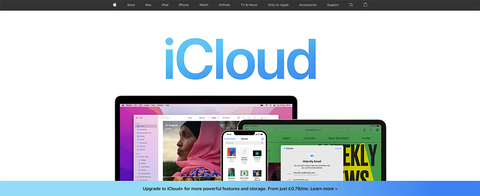TechRadar Verdict
Apple iCloud Drive has made significant strides forward in recent years, and is now much better placed to take on the likes of OneDrive, Google Drive and Dropbox. It's still limited in some areas though, and is only of any significant use to users of Apple's desktop and mobile hardware.
Pros
- +
Good Apple mobile and desktop integration
- +
Sharing options are improving
- +
Polished and slick user interface
- +
5GB free cloud storage
Cons
- -
Apple-centric
- -
No Android support, limited Windows support
- -
Still lacks some advanced features
- -
Very few options for power users
Why you can trust TechRadar
Apple iCloud Drive continues to add new features and improvements, and they're certainly needed: Apple was slow out of the blocks with iCloud. For a long time, the service lagged behind the more polished of the best cloud storage providers, like Microsoft, Google, and Dropbox.
There are signs of Apple finding its feet with iCloud Drive though. The addition of new features like folder sharing is welcome, and integration with macOS and iOS keeps getting better all the time.
iCloud Drive: Pricing & plans
Apple gives everyone 5GB of storage space for free with iCloud Drive. It’s not quite as generous some of the best free cloud storage services, less than Google Drive and on par with OneDrive. That 5GB won’t stretch far if you're syncing a lot of videos and photos to the cloud. After you've used up all that, you need to pay a monthly fee for some extra space.
Users have a choice of three tiers: 50GB for $0.99 a month, 200GB for $2.99 a month, or 2TB for $9.99 a month.
That's broadly comparable with the consumer cloud storage services offered by rivals, including Google Drive and Microsoft OneDrive. If you stop paying, your files don't go anywhere, but you won't be able to upload anything new.
All paid plans - known as iCloud+ - also include iCloud Private Relay which masks your IP address for a sense of anonymity online, the option to create multiple unique, random email addresses to sign up to third party apps known as Hide My Email, support for custom email domains, and storage for one, five, or unlimited HomeKit Secure Video-compatible cameras depending on the plan.
Three bundles are also available, only one of which is aimed at individuals. Along with 50GB of iCloud+ storage, it brings Apple Music, Apple TV+ and Apple Arcade subscriptions for $16.95 a month.
Family plans upgrade the iCloud+ storage to 200GB, priced at $22.95 a month, and top-tier Premier plans add Apple News+, Apple Fitness+ and 2TB of iCloud+ storage for $32.95 (£32.95) per month.
iCloud Drive really makes the most sense for those already in the Apple ecosystem - in the same way OneDrive is best paired with Windows and Microsoft 365. With that in mind, we like the range of options and bundles available to help multi-service subscribers save money.
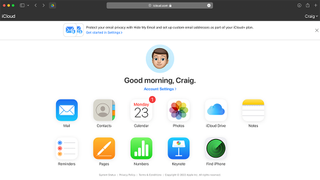
iCloud Drive: Interface
It’s no surprise that iCloud Drive is tightly integrated into macOS and iOS. Even if you don't sign up for extra storage, and don't use iCloud as your photo cloud storage, it's still deeply embedded in operating systems, if only to manage app backups and calendar and contact syncing.
iCloud Drive is right there inside the Finder on macOS, and you can also find a variety of options in System Preferences too. While it isn't able to back up an entire machine, it gets pretty close considering you can reinstall macOS and your programs from the web. Just about everything else that matters can be stored in iCloud. From what we can tell, file transfers are usually speedy and almost instantaneous.
If you're using iCloud Drive for Windows, the app will sit quite happily in your system tray. Just don't expect a great deal of feedback, as if you're syncing files it will simply tell you the number remaining, not report back on progress.
Over on iOS, there is now a dedicated Files app with its own iCloud Drive section. You can copy, move, delete and share files without too much trouble, and everything has the usual visual appeal and slickness you would expect from Apple.
Support is non-existent for Android though – unless you count logging into the iCloud web portal in an Android browser, which is a tortuous process.
No matter which platform you use, iCloud Drive doesn't have the advanced feature seen in other cloud storage clients such as being able to limit download/upload speeds.
On the other hand the iCloud website has improved significantly in recent years, making it much easier to get at your files. You still can't stream videos directly from the web, unfortunately, but you can stream audio files as long as they're saved in common formats as well as preview images.
We especially like the way that Files for iOS can display other cloud drives - like Google Drive and Microsoft OneDrive - directly in the app. Not only does this eliminate the need to go in via the third party app (it still needs to be installed on your device), but it should make syncing and accessing files easier with Apple offering a better, more consistent user experience for native apps.
In terms of the interface, everything about iCloud Drive is pretty much in line with the other software Apple makes. It's mostly polished and smooth, with a few occasional quirks. At least iCloud Drive no longer looks like a tagged-on afterthought whenever it appears, which was the case when it first appeared.

iCloud Drive: Features
As well as backing up data from certain apps - and this is really dependent on the app developer working with Apple to ensure compatibility - iCloud Drive is now a user-facing, more conventional cloud storage service:. It has its own entries in the Finder on macOS, and has its own apps on iPhones and iPads. The idea is you can back up anything you like, from PDF documents to images, to Apple's servers and get at it from anywhere.
To sign in to iCloud Drive, you'll need to create your own Apple ID. If this is the first time you've used one, you'll need to sign in to a Mac or iOS device first before being able to use iCloud Drive for windows.
Our tests showed that iCloud Drive is only really of use for those on Apple hardware anyway.
We found the biggest advantage to the software is that it just works without needing our attention or interference: it's not as hidden as it once was, but it's still designed to operate largely in the background, syncing your important files between mobile and desktop devices. Anything that gets added to your iCloud Drive is synced to the web, and on a Mac you can opt to include the Desktop and Documents folders as well.
iCloud Drive can run unobtrusively, automatically syncing files and optimizing space on your Mac’s hard drive. A couple of tests using the browser portal on an Apple device brought up the results we were expecting: the service can keep up with its competition and your own broadband connection is likely to be the limiting factor.
Because iCloud Drive is so closely integrated with the macOS experience, finding the various settings can pose its own challenges. Many of the user’s day-to-day experiences will lie in Finder, but certain settings are found in System Preferences - the app that controls computer-wide settings.
This includes the option to toggle on and off Optimize Mac Storage, which promises to keep files downloaded to your computer if you have enough space, and to remove these local copies as and when you run out of space. Other cloud storage solutions offer this too, but Apple is smart in the way that it optimizes this based on your frequently used files - it’s not as black and white as on or off. While this is great, some users would prefer more control over this, which cannot be had.
Basic file and folder sharing is included, but there's no native versioning for all files, so you can't get back older versions of files. Collaborating with others is best done using the macOS and iOS apps, however there is basic browser access for those working from other operating systems.
iCloud Drive: Security
While iCloud Drive data is encrypted to keep it safe from prying eyes, not everything is end-to-end encrypted by default – that means Apple can technically get at the data if it wanted to, though there's no reason to suspect it would. Many other cloud storage services take the same approach, not least to make sure your files can be accessed easily from anywhere.
Still, in 2016 Apple faced off with the FBI by refusing to create a 'backdoor' into a suspect's iPhone, citing user privacy. Since then, with iCloud's Standard Data Protection, certain data is protected via end-to-end encryption such as Health and the passwords stored in your iCloud Keychain.
As of iOS 16.2 and macOS 13.1, iCloud users can also choose to enable Advanced Data Protection. This protects even more services with end-to-end encryption including iCloud Backups, Photos, Notes and more. Apple's Support Pages lists exactly what's secured in this way and what isn't.
Apple accounts can also be protected with two-factor authentication and we would strongly recommend that you switch this on. This means that even if your username and password are exposed, unwelcome visitors can't get at your data without an extra code that's displayed on your phone or laptop - or, of course, by SMS. Apple has confirmed that signing in via 2FA is mandatory for new Apple ID's anyway, which is a huge step in the right direction. If you're already signed on an Apple device, you can approve login requests on new ones via a code.
Overall, we found Apple and iCloud Drive do an impressive job of data security.
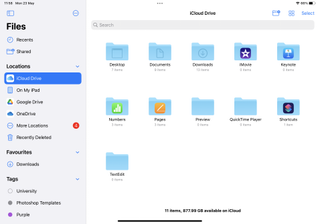
iCloud Drive: Our tests
We measured sync speed, file recovery, and versioning in Apple iCloud Drive. Tests were conducted on a Windows 11 virtual machine running the Windows iCloud desktop client.
This VM was connected to the internet via fiber broadband and VPN server that showed average upload speeds of 70 Mbps

- Test 1 - Sync speed
When we set up iCloud Drive on Windows, the client automatically created an 'iCloud Drive' folder in our home directory.
After copying our test files into this folder, the iCloud client stated it was “syncing 23 files”. There was no information on upload speed or the progress of individual files. After 12 minutes none of the files showed as synced, nor did they appear on the iCloud website.
We tried to pause the transfer and quit the iCloud Windows client but there are no options for this. Eventually we were able to stop it through pressing Ctrl + Alt + Del and invoking the Task Manager.
We next tried to upload the test files directly to the iCloud online portal. We had much more success here.
Firstly the website explained it was unable to upload one of the files which had an unusual '.trigger' extension as it registered as 0 bytes in size. Still the remaining files began uploading immediately and we could see the progress of each one.
In total our test folder of 22 files (625MB) took just over 90 seconds to upload. This is exactly what we expected for a 70 Mbps connection. It's just a shame we had to bypass the iCloud Desktop client to do it.
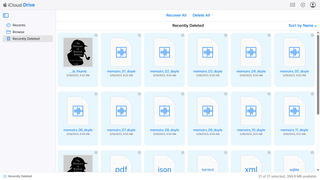
- Test 2 - File recovery
After uploading our test files via the iCloud website we checked the iCloud Drive folder on our device to see if they'd been synced there too. They hadn't.
Still, when we deleted the files via the iCloud website, they were immediately sent to Recently Deleted. Upon clicking on that section we were also able to choose Recover All. We used the iCloud website's preview feature to open up a couple of images and play some of the sound files to confirm recovery was a success - again, without using Apple's iCloud software for Windows.
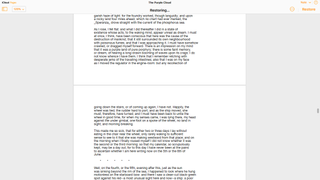
- Test 3 - Versioning
For this test, we placed our test document - a .docx file - in the iCloud Drive home directory. Again we were stuck with the “uploading” message for minutes on end.
We were able to upload the test file to iCloud Drive via the website. However, since it was a Microsoft Word document we couldn't preview or edit it, just download it again.
Since iCloud also offers an online version of Apple Pages, we decided to create a new online Pages document and paste the text of the document in there. We edited the file to remove all text but the intro and saved our changes. The iCloud version of Pages recognized our changes and showed a version history, which we used to restore the original document.
Again, this underscores the message that iCloud is great, so long as you’re running Apple devices and its ecosystem of apps.
iCloud Drive: Verdict
iCloud Drive is a lot better than it used to be, and is now a proper cloud storage solution to compete with rivals from Dropbox, Microsoft OneDrive, Google Drive, and others. However, despite recent improvements, it still doesn't offer quite as much as those other services – most obviously when it comes to having an Android app of any description, but also with lacking advanced features such as versioning and selective sync.
There are better cloud storage services out there. But if you’re already an Apple user, you’ll find iCloud Drive so well integrated into the company’s devices and apps that you might never need to switch to an alternative. macOS and iOS will always default to iCloud, so it's the most convenient option, but if you're otherwise looking to pay for a service we think your money is probably better spent elsewhere.
Mark is an expert on 3D printers, drones and phones. He also covers storage, including SSDs, NAS drives and portable hard drives. He started writing in 1986 and has contributed to MicroMart, PC Format, 3D World, among others.
- David NieldFreelance Contributor
- Nate Drake
- Craig Hale
